The History, Role, Strengths and Weaknesses of the World Trade Organization (WTO) and Benefits and Costs of Resolving an International Commercial Dispute by Arbitration in Australia
VerifiedAdded on 2023/06/07
|9
|2682
|348
AI Summary
This article discusses the history, role, strengths and weaknesses of the World Trade Organization (WTO) and the benefits and costs of resolving an international commercial dispute by arbitration in Australia. It also covers the advantages and disadvantages of arbitration and the procedure of alternative dispute resolution. The article provides a detailed analysis of the WTO's role in regulating international trade and resolving disputes between nations. It also highlights the benefits of resolving international commercial disputes by arbitration in Australia, including the country's strong legal system and detailed procedural rules.
Contribute Materials
Your contribution can guide someone’s learning journey. Share your
documents today.
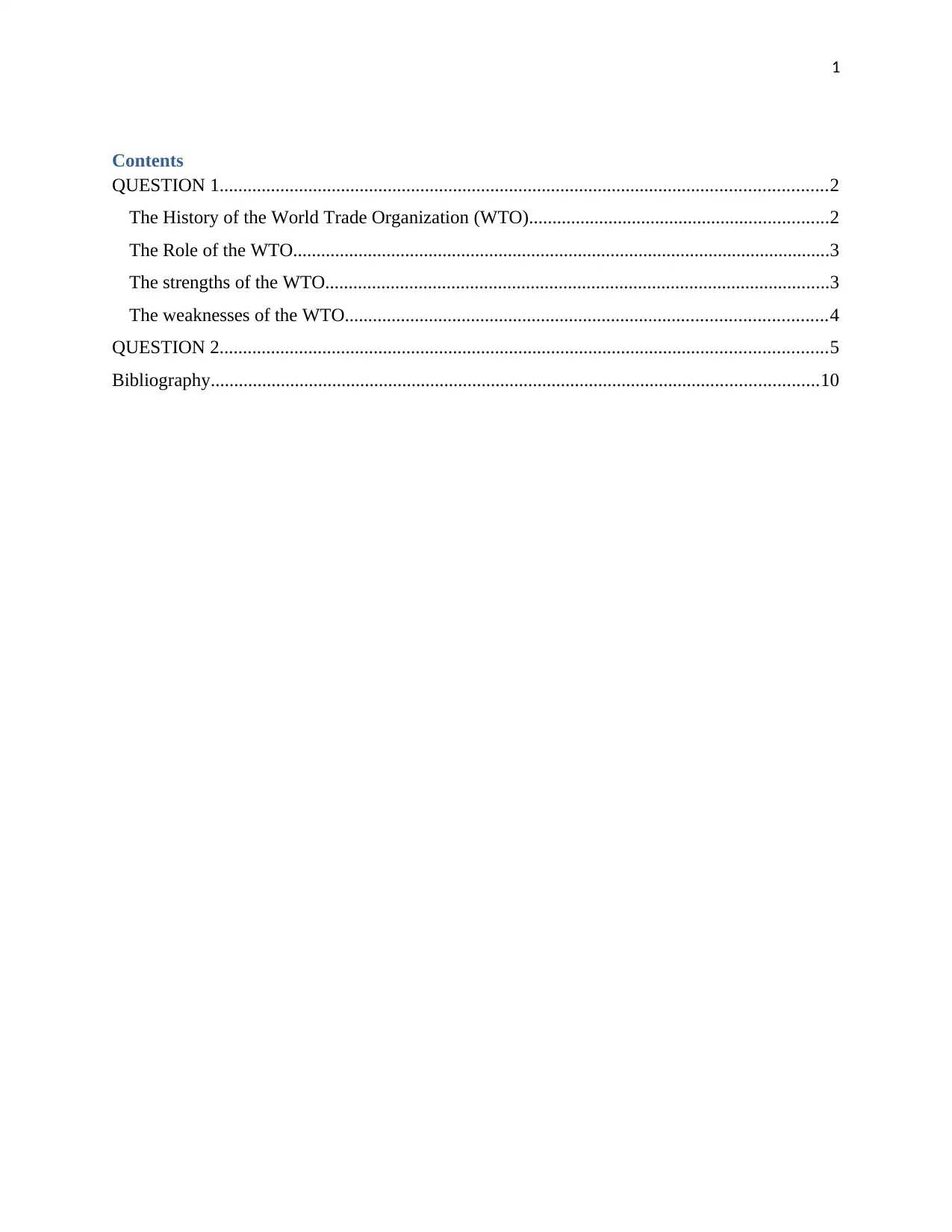
1
Contents
QUESTION 1..................................................................................................................................2
The History of the World Trade Organization (WTO)................................................................2
The Role of the WTO...................................................................................................................3
The strengths of the WTO............................................................................................................3
The weaknesses of the WTO.......................................................................................................4
QUESTION 2..................................................................................................................................5
Bibliography..................................................................................................................................10
Contents
QUESTION 1..................................................................................................................................2
The History of the World Trade Organization (WTO)................................................................2
The Role of the WTO...................................................................................................................3
The strengths of the WTO............................................................................................................3
The weaknesses of the WTO.......................................................................................................4
QUESTION 2..................................................................................................................................5
Bibliography..................................................................................................................................10
Secure Best Marks with AI Grader
Need help grading? Try our AI Grader for instant feedback on your assignments.

2
QUESTION 1
World Trade Organization is one of the most prestigious International Organizations that aims at
bring harmony, peace and co-operation amid the national and international nations. The history,
its role and its strength and weakness are analyzed in the present section.
The History of the World Trade Organization (WTO)
In 1947, the Second World War was over. But from the ashes of the World War II arose
International Monetary Fund and The General Agreement on Tariffs and Trade (GATT). The
mains reasons for the development of these two international bodies are the fear that has
immerged from the destruction and damage that has been left after the war. Thus, the
international bodies intend to start novel and afresh. 1However, GATT though has been
established with all new hopes by an international co-operation, but, there were endless regional
and national conflicts that resulted in Cold war and eventually in the development of the World
Trade Organization which inherited GATT2.
On 15th April 1994, around 124 nations entered into a Marrakesh Agreement wherein they
replaced GATT and resulted in the official establishment of WTO3.
The international trade is regulated by the WTO. With the increase in globalization there arose a
need for an international organization which has the capacity to manage the trading system amid
the international and national communities. With the increase in trade there are various problems
arose, such as, trade barriers, protectionism, infringement of intellectual properties, subsidies etc.
This is mainly because the trading system of every nation is different from each other. With the
establishment of the WTO, a mediator is created amid the nations wherein it acts as a dispute
resolute in case if any disputes are arisen amid the nations. It is the Ministerial Conference of the
highest decision making body of WTO that meets in every two years. All members are joined
together to deal with the matters that comes under the multinational trade agreements4.
1 Craig VanGrasstek, The History and Future of the World Trade Organization, 2013,
<https://www.wto.org/english/res_e/booksp_e/historywto_e.pdf>
2 Usman, Adamu Kyuka, Theory and Practice of International Economic Law, (Malthouse Press, 2017).
3 Anne O. Krueger, International Economic Organizations, Developing Country Reforms, and Trade, The National Bureau of
National Research <http://www.nber.org/reporter/winter00/krueger.html>.
4 Chad P. Bown, Self-Enforcing Trade: Developing Countries and WTO Dispute Settlement, (Brookings Institution Press, 01-
Feb-2010).
QUESTION 1
World Trade Organization is one of the most prestigious International Organizations that aims at
bring harmony, peace and co-operation amid the national and international nations. The history,
its role and its strength and weakness are analyzed in the present section.
The History of the World Trade Organization (WTO)
In 1947, the Second World War was over. But from the ashes of the World War II arose
International Monetary Fund and The General Agreement on Tariffs and Trade (GATT). The
mains reasons for the development of these two international bodies are the fear that has
immerged from the destruction and damage that has been left after the war. Thus, the
international bodies intend to start novel and afresh. 1However, GATT though has been
established with all new hopes by an international co-operation, but, there were endless regional
and national conflicts that resulted in Cold war and eventually in the development of the World
Trade Organization which inherited GATT2.
On 15th April 1994, around 124 nations entered into a Marrakesh Agreement wherein they
replaced GATT and resulted in the official establishment of WTO3.
The international trade is regulated by the WTO. With the increase in globalization there arose a
need for an international organization which has the capacity to manage the trading system amid
the international and national communities. With the increase in trade there are various problems
arose, such as, trade barriers, protectionism, infringement of intellectual properties, subsidies etc.
This is mainly because the trading system of every nation is different from each other. With the
establishment of the WTO, a mediator is created amid the nations wherein it acts as a dispute
resolute in case if any disputes are arisen amid the nations. It is the Ministerial Conference of the
highest decision making body of WTO that meets in every two years. All members are joined
together to deal with the matters that comes under the multinational trade agreements4.
1 Craig VanGrasstek, The History and Future of the World Trade Organization, 2013,
<https://www.wto.org/english/res_e/booksp_e/historywto_e.pdf>
2 Usman, Adamu Kyuka, Theory and Practice of International Economic Law, (Malthouse Press, 2017).
3 Anne O. Krueger, International Economic Organizations, Developing Country Reforms, and Trade, The National Bureau of
National Research <http://www.nber.org/reporter/winter00/krueger.html>.
4 Chad P. Bown, Self-Enforcing Trade: Developing Countries and WTO Dispute Settlement, (Brookings Institution Press, 01-
Feb-2010).

3
It is now important to understand the main role that is catered by WTO
The Role of the WTO
There is no single role or function that can be attributed to WTO. The prime role that is
undertaken by WTO includes5:
i. The most important function that can be attributed to WTO is that it takes a check on
the administration, operation and implementation of the covered agreements;
ii. Whenever a dispute arose amid the international parties then it acts as a podium
where disputes can be settled and negotiations can take place.
iii. Procedures and Rules are framed by WTO in order to resolve the disputes.
iv. The national trade policies are propagated and reviewed by WTO;
v. A global economic policy making is established so that there is transparency and
coherency in the trade policies;
vi. WTO makes sure that the low income and least developed countries must be provided
assistance so that they can comply with the rules and disciplines of WTO by
providing training and technical co-operation;
vii. A framework must be provided for the administration, operation and implementation
of the Multilateral Trade Agreements;
viii. It must act in cooperation with international Monetary Fund (IMF) and with the
International Bank for Reconstruction and Development (IBRD) to achieve a global
economic policy.
ix. It helps in the regulation of trade in services and goods;
x. It makes sure that there should not any kind of discrimination that prevails;
It is now important to understand the strengths and weakness of WTO.
The strengths of the WTO
Some of the strengths of WTO include6:
5 Craig VanGrasstek, n1.
6 Arialilaloblog, Strengths and weakness of WTO, 2018 <http://www.ariafilaloblog.com/blog/strengths-weaknesses-
international-trade/>
It is now important to understand the main role that is catered by WTO
The Role of the WTO
There is no single role or function that can be attributed to WTO. The prime role that is
undertaken by WTO includes5:
i. The most important function that can be attributed to WTO is that it takes a check on
the administration, operation and implementation of the covered agreements;
ii. Whenever a dispute arose amid the international parties then it acts as a podium
where disputes can be settled and negotiations can take place.
iii. Procedures and Rules are framed by WTO in order to resolve the disputes.
iv. The national trade policies are propagated and reviewed by WTO;
v. A global economic policy making is established so that there is transparency and
coherency in the trade policies;
vi. WTO makes sure that the low income and least developed countries must be provided
assistance so that they can comply with the rules and disciplines of WTO by
providing training and technical co-operation;
vii. A framework must be provided for the administration, operation and implementation
of the Multilateral Trade Agreements;
viii. It must act in cooperation with international Monetary Fund (IMF) and with the
International Bank for Reconstruction and Development (IBRD) to achieve a global
economic policy.
ix. It helps in the regulation of trade in services and goods;
x. It makes sure that there should not any kind of discrimination that prevails;
It is now important to understand the strengths and weakness of WTO.
The strengths of the WTO
Some of the strengths of WTO include6:
5 Craig VanGrasstek, n1.
6 Arialilaloblog, Strengths and weakness of WTO, 2018 <http://www.ariafilaloblog.com/blog/strengths-weaknesses-
international-trade/>
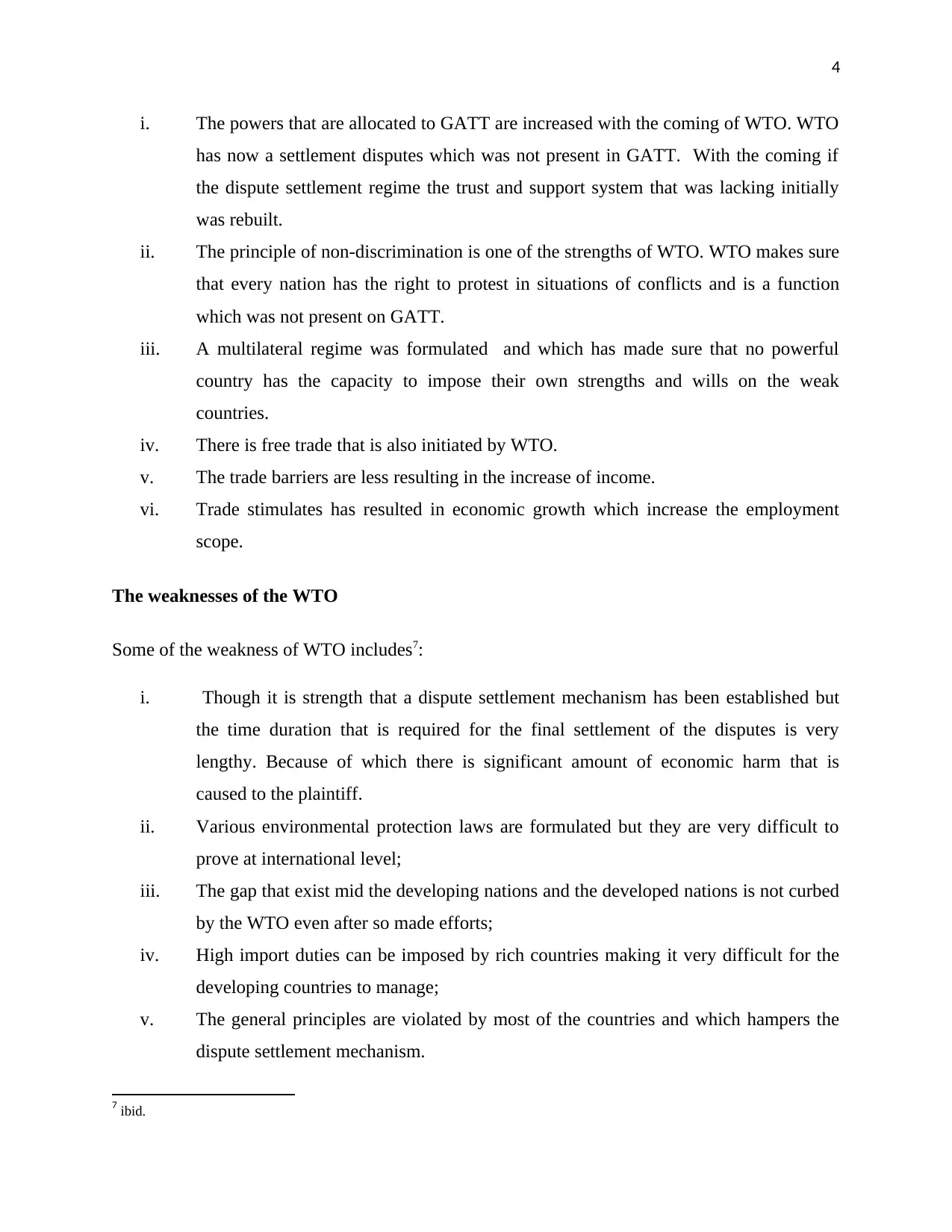
4
i. The powers that are allocated to GATT are increased with the coming of WTO. WTO
has now a settlement disputes which was not present in GATT. With the coming if
the dispute settlement regime the trust and support system that was lacking initially
was rebuilt.
ii. The principle of non-discrimination is one of the strengths of WTO. WTO makes sure
that every nation has the right to protest in situations of conflicts and is a function
which was not present on GATT.
iii. A multilateral regime was formulated and which has made sure that no powerful
country has the capacity to impose their own strengths and wills on the weak
countries.
iv. There is free trade that is also initiated by WTO.
v. The trade barriers are less resulting in the increase of income.
vi. Trade stimulates has resulted in economic growth which increase the employment
scope.
The weaknesses of the WTO
Some of the weakness of WTO includes7:
i. Though it is strength that a dispute settlement mechanism has been established but
the time duration that is required for the final settlement of the disputes is very
lengthy. Because of which there is significant amount of economic harm that is
caused to the plaintiff.
ii. Various environmental protection laws are formulated but they are very difficult to
prove at international level;
iii. The gap that exist mid the developing nations and the developed nations is not curbed
by the WTO even after so made efforts;
iv. High import duties can be imposed by rich countries making it very difficult for the
developing countries to manage;
v. The general principles are violated by most of the countries and which hampers the
dispute settlement mechanism.
7 ibid.
i. The powers that are allocated to GATT are increased with the coming of WTO. WTO
has now a settlement disputes which was not present in GATT. With the coming if
the dispute settlement regime the trust and support system that was lacking initially
was rebuilt.
ii. The principle of non-discrimination is one of the strengths of WTO. WTO makes sure
that every nation has the right to protest in situations of conflicts and is a function
which was not present on GATT.
iii. A multilateral regime was formulated and which has made sure that no powerful
country has the capacity to impose their own strengths and wills on the weak
countries.
iv. There is free trade that is also initiated by WTO.
v. The trade barriers are less resulting in the increase of income.
vi. Trade stimulates has resulted in economic growth which increase the employment
scope.
The weaknesses of the WTO
Some of the weakness of WTO includes7:
i. Though it is strength that a dispute settlement mechanism has been established but
the time duration that is required for the final settlement of the disputes is very
lengthy. Because of which there is significant amount of economic harm that is
caused to the plaintiff.
ii. Various environmental protection laws are formulated but they are very difficult to
prove at international level;
iii. The gap that exist mid the developing nations and the developed nations is not curbed
by the WTO even after so made efforts;
iv. High import duties can be imposed by rich countries making it very difficult for the
developing countries to manage;
v. The general principles are violated by most of the countries and which hampers the
dispute settlement mechanism.
7 ibid.
Secure Best Marks with AI Grader
Need help grading? Try our AI Grader for instant feedback on your assignments.

5
vi. There is lack of transparency making the organization a home for rich and not for the
poor nations;
Thus, these are the some of the strengths and weaknesses that can be attributed to WTO.
Regardless of the weakness that is attributed to WTO, there is no discussion to the fact that the
emergence of WTO is one of the significant actions that are taken at international level which
has tried to achieve peace and harmony amid the global nations.8
QUESTION 2
Alternative Dispute Resolution is a mechanism or a non-judicial function which is required to
resolve the disputes that arise amid the parties without the interference of the courts. In order to
achieve fairness, cost effectives, parties are moving from litigation to Alternative Dispute
Resolution mechanism. The most common type of Alternative Dispute Resolution that are
normally found are Mediation, Early Neutral Evaluation, Expert Determination and Arbitration9
Arbitration is a kind of Alternative Dispute Resolution process wherein the parties present
evidence and arguments to the arbitrator who then makes a determination which is binding and
final and the award is enforceable. It is a private and confidential process. It is an effective and
flexible mechanism to resolve the disputes at both national and intentional level10.
The main advantages and disadvantages that are attributed to the process of arbitration are:
Advantages 11
The main advantages that can be attributed to the process of arbitration include:
i. The process of arbitration is not time consuming and the disputes are resolved in a
timely manner.
8 Larissa Behrendt , Aboriginal Dispute Resolution: A Step Towards Self-determination and Community Autonomy, (Federation
Press, 1995).
9Graham Maher, Alternative Dispute Resolution: Trends, Traps and Benefits, 2012<
http://www.mondaq.com/australia/x/170796/Arbitration+Dispute+Resolution/
Alternative+Dispute+Resolution+Trends+Traps+and+Benefits
10 Karl J Mackie and Karl Mackie, A Handbook of Dispute Resolution: ADR in Action, (Routledge, 11-Jan-2013).
11 Vishnu S. Warrier, Arbitration, Conciliation and Mediation, LexisNexis, 2015.
vi. There is lack of transparency making the organization a home for rich and not for the
poor nations;
Thus, these are the some of the strengths and weaknesses that can be attributed to WTO.
Regardless of the weakness that is attributed to WTO, there is no discussion to the fact that the
emergence of WTO is one of the significant actions that are taken at international level which
has tried to achieve peace and harmony amid the global nations.8
QUESTION 2
Alternative Dispute Resolution is a mechanism or a non-judicial function which is required to
resolve the disputes that arise amid the parties without the interference of the courts. In order to
achieve fairness, cost effectives, parties are moving from litigation to Alternative Dispute
Resolution mechanism. The most common type of Alternative Dispute Resolution that are
normally found are Mediation, Early Neutral Evaluation, Expert Determination and Arbitration9
Arbitration is a kind of Alternative Dispute Resolution process wherein the parties present
evidence and arguments to the arbitrator who then makes a determination which is binding and
final and the award is enforceable. It is a private and confidential process. It is an effective and
flexible mechanism to resolve the disputes at both national and intentional level10.
The main advantages and disadvantages that are attributed to the process of arbitration are:
Advantages 11
The main advantages that can be attributed to the process of arbitration include:
i. The process of arbitration is not time consuming and the disputes are resolved in a
timely manner.
8 Larissa Behrendt , Aboriginal Dispute Resolution: A Step Towards Self-determination and Community Autonomy, (Federation
Press, 1995).
9Graham Maher, Alternative Dispute Resolution: Trends, Traps and Benefits, 2012<
http://www.mondaq.com/australia/x/170796/Arbitration+Dispute+Resolution/
Alternative+Dispute+Resolution+Trends+Traps+and+Benefits
10 Karl J Mackie and Karl Mackie, A Handbook of Dispute Resolution: ADR in Action, (Routledge, 11-Jan-2013).
11 Vishnu S. Warrier, Arbitration, Conciliation and Mediation, LexisNexis, 2015.
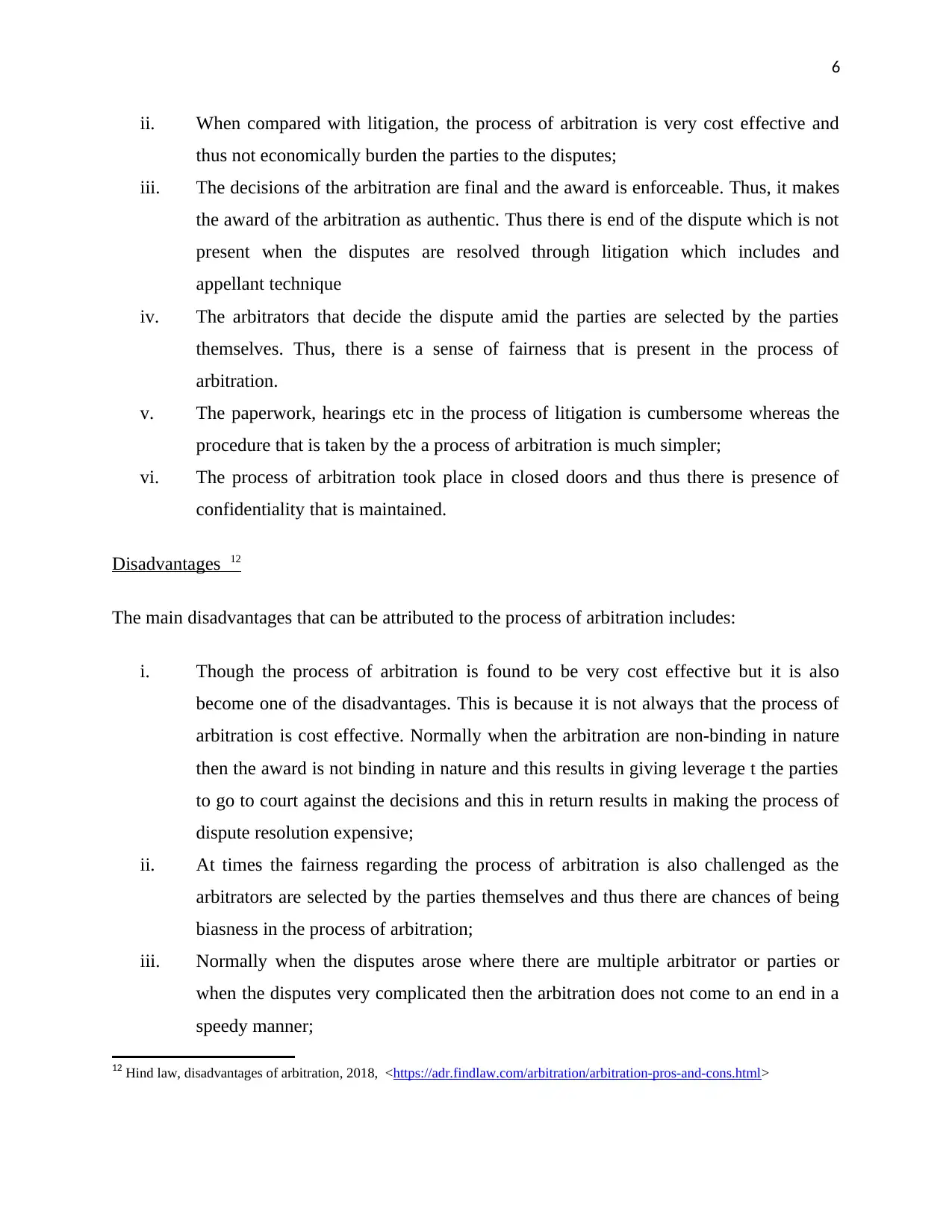
6
ii. When compared with litigation, the process of arbitration is very cost effective and
thus not economically burden the parties to the disputes;
iii. The decisions of the arbitration are final and the award is enforceable. Thus, it makes
the award of the arbitration as authentic. Thus there is end of the dispute which is not
present when the disputes are resolved through litigation which includes and
appellant technique
iv. The arbitrators that decide the dispute amid the parties are selected by the parties
themselves. Thus, there is a sense of fairness that is present in the process of
arbitration.
v. The paperwork, hearings etc in the process of litigation is cumbersome whereas the
procedure that is taken by the a process of arbitration is much simpler;
vi. The process of arbitration took place in closed doors and thus there is presence of
confidentiality that is maintained.
Disadvantages 12
The main disadvantages that can be attributed to the process of arbitration includes:
i. Though the process of arbitration is found to be very cost effective but it is also
become one of the disadvantages. This is because it is not always that the process of
arbitration is cost effective. Normally when the arbitration are non-binding in nature
then the award is not binding in nature and this results in giving leverage t the parties
to go to court against the decisions and this in return results in making the process of
dispute resolution expensive;
ii. At times the fairness regarding the process of arbitration is also challenged as the
arbitrators are selected by the parties themselves and thus there are chances of being
biasness in the process of arbitration;
iii. Normally when the disputes arose where there are multiple arbitrator or parties or
when the disputes very complicated then the arbitration does not come to an end in a
speedy manner;
12 Hind law, disadvantages of arbitration, 2018, <https://adr.findlaw.com/arbitration/arbitration-pros-and-cons.html>
ii. When compared with litigation, the process of arbitration is very cost effective and
thus not economically burden the parties to the disputes;
iii. The decisions of the arbitration are final and the award is enforceable. Thus, it makes
the award of the arbitration as authentic. Thus there is end of the dispute which is not
present when the disputes are resolved through litigation which includes and
appellant technique
iv. The arbitrators that decide the dispute amid the parties are selected by the parties
themselves. Thus, there is a sense of fairness that is present in the process of
arbitration.
v. The paperwork, hearings etc in the process of litigation is cumbersome whereas the
procedure that is taken by the a process of arbitration is much simpler;
vi. The process of arbitration took place in closed doors and thus there is presence of
confidentiality that is maintained.
Disadvantages 12
The main disadvantages that can be attributed to the process of arbitration includes:
i. Though the process of arbitration is found to be very cost effective but it is also
become one of the disadvantages. This is because it is not always that the process of
arbitration is cost effective. Normally when the arbitration are non-binding in nature
then the award is not binding in nature and this results in giving leverage t the parties
to go to court against the decisions and this in return results in making the process of
dispute resolution expensive;
ii. At times the fairness regarding the process of arbitration is also challenged as the
arbitrators are selected by the parties themselves and thus there are chances of being
biasness in the process of arbitration;
iii. Normally when the disputes arose where there are multiple arbitrator or parties or
when the disputes very complicated then the arbitration does not come to an end in a
speedy manner;
12 Hind law, disadvantages of arbitration, 2018, <https://adr.findlaw.com/arbitration/arbitration-pros-and-cons.html>
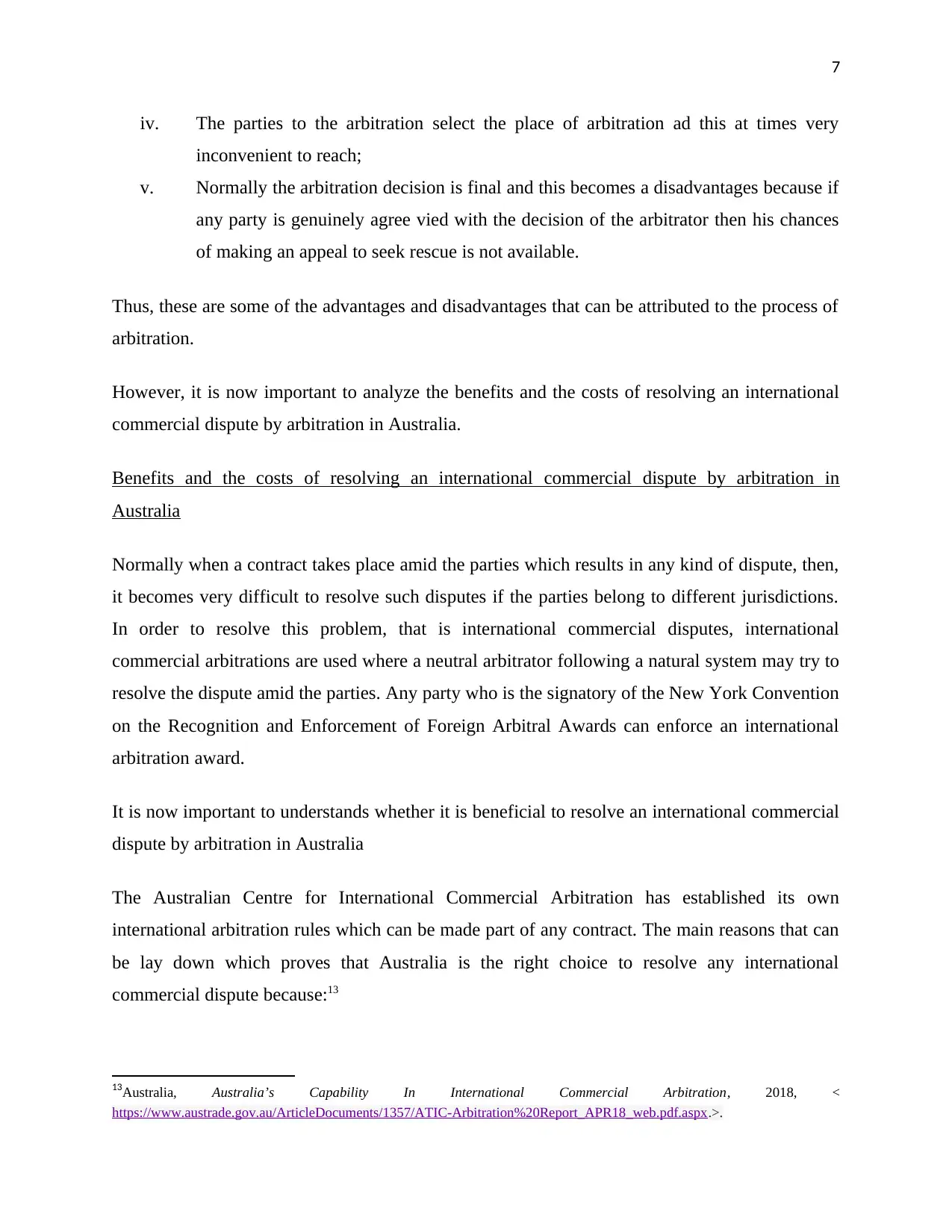
7
iv. The parties to the arbitration select the place of arbitration ad this at times very
inconvenient to reach;
v. Normally the arbitration decision is final and this becomes a disadvantages because if
any party is genuinely agree vied with the decision of the arbitrator then his chances
of making an appeal to seek rescue is not available.
Thus, these are some of the advantages and disadvantages that can be attributed to the process of
arbitration.
However, it is now important to analyze the benefits and the costs of resolving an international
commercial dispute by arbitration in Australia.
Benefits and the costs of resolving an international commercial dispute by arbitration in
Australia
Normally when a contract takes place amid the parties which results in any kind of dispute, then,
it becomes very difficult to resolve such disputes if the parties belong to different jurisdictions.
In order to resolve this problem, that is international commercial disputes, international
commercial arbitrations are used where a neutral arbitrator following a natural system may try to
resolve the dispute amid the parties. Any party who is the signatory of the New York Convention
on the Recognition and Enforcement of Foreign Arbitral Awards can enforce an international
arbitration award.
It is now important to understands whether it is beneficial to resolve an international commercial
dispute by arbitration in Australia
The Australian Centre for International Commercial Arbitration has established its own
international arbitration rules which can be made part of any contract. The main reasons that can
be lay down which proves that Australia is the right choice to resolve any international
commercial dispute because:13
13Australia, Australia’s Capability In International Commercial Arbitration, 2018, <
https://www.austrade.gov.au/ArticleDocuments/1357/ATIC-Arbitration%20Report_APR18_web.pdf.aspx.>.
iv. The parties to the arbitration select the place of arbitration ad this at times very
inconvenient to reach;
v. Normally the arbitration decision is final and this becomes a disadvantages because if
any party is genuinely agree vied with the decision of the arbitrator then his chances
of making an appeal to seek rescue is not available.
Thus, these are some of the advantages and disadvantages that can be attributed to the process of
arbitration.
However, it is now important to analyze the benefits and the costs of resolving an international
commercial dispute by arbitration in Australia.
Benefits and the costs of resolving an international commercial dispute by arbitration in
Australia
Normally when a contract takes place amid the parties which results in any kind of dispute, then,
it becomes very difficult to resolve such disputes if the parties belong to different jurisdictions.
In order to resolve this problem, that is international commercial disputes, international
commercial arbitrations are used where a neutral arbitrator following a natural system may try to
resolve the dispute amid the parties. Any party who is the signatory of the New York Convention
on the Recognition and Enforcement of Foreign Arbitral Awards can enforce an international
arbitration award.
It is now important to understands whether it is beneficial to resolve an international commercial
dispute by arbitration in Australia
The Australian Centre for International Commercial Arbitration has established its own
international arbitration rules which can be made part of any contract. The main reasons that can
be lay down which proves that Australia is the right choice to resolve any international
commercial dispute because:13
13Australia, Australia’s Capability In International Commercial Arbitration, 2018, <
https://www.austrade.gov.au/ArticleDocuments/1357/ATIC-Arbitration%20Report_APR18_web.pdf.aspx.>.
Paraphrase This Document
Need a fresh take? Get an instant paraphrase of this document with our AI Paraphraser
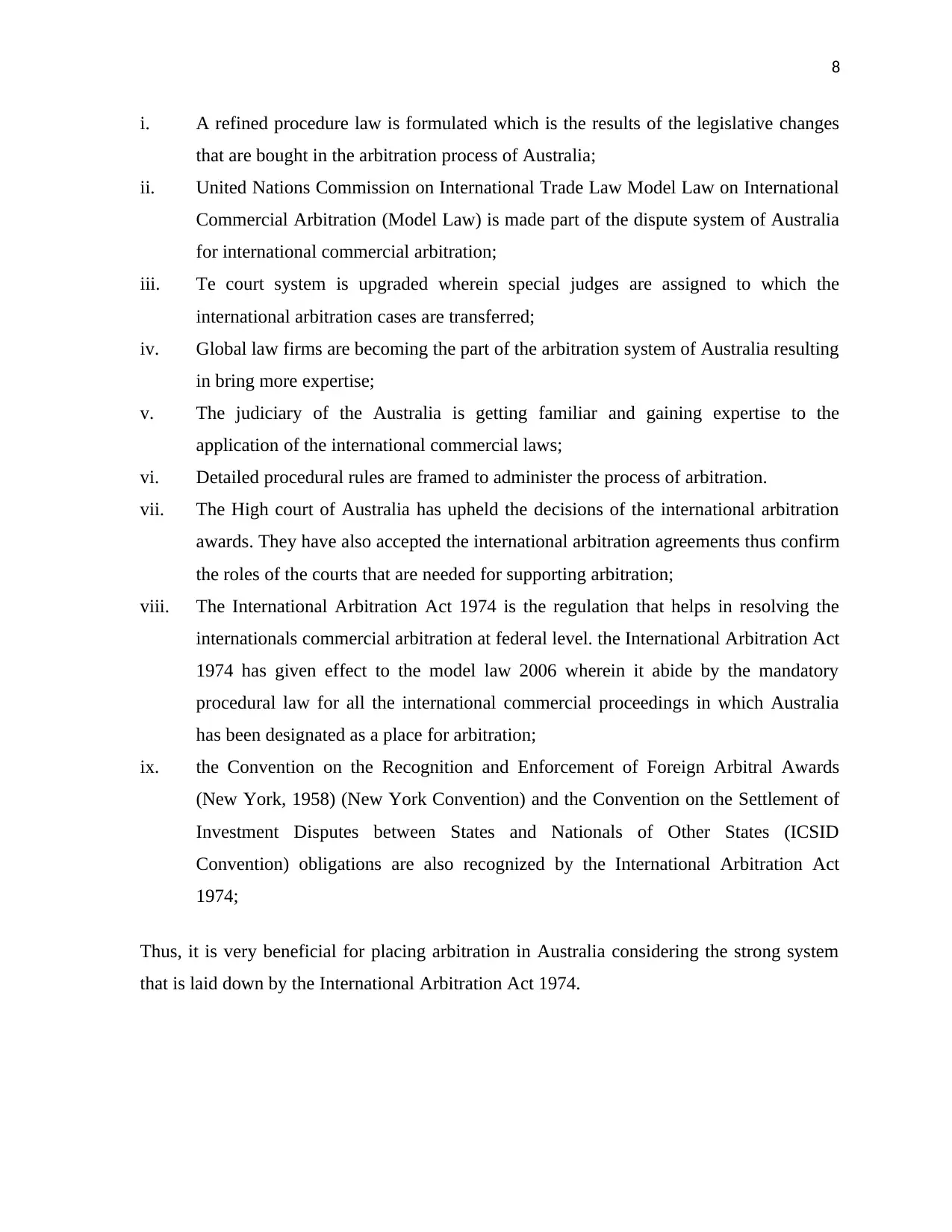
8
i. A refined procedure law is formulated which is the results of the legislative changes
that are bought in the arbitration process of Australia;
ii. United Nations Commission on International Trade Law Model Law on International
Commercial Arbitration (Model Law) is made part of the dispute system of Australia
for international commercial arbitration;
iii. Te court system is upgraded wherein special judges are assigned to which the
international arbitration cases are transferred;
iv. Global law firms are becoming the part of the arbitration system of Australia resulting
in bring more expertise;
v. The judiciary of the Australia is getting familiar and gaining expertise to the
application of the international commercial laws;
vi. Detailed procedural rules are framed to administer the process of arbitration.
vii. The High court of Australia has upheld the decisions of the international arbitration
awards. They have also accepted the international arbitration agreements thus confirm
the roles of the courts that are needed for supporting arbitration;
viii. The International Arbitration Act 1974 is the regulation that helps in resolving the
internationals commercial arbitration at federal level. the International Arbitration Act
1974 has given effect to the model law 2006 wherein it abide by the mandatory
procedural law for all the international commercial proceedings in which Australia
has been designated as a place for arbitration;
ix. the Convention on the Recognition and Enforcement of Foreign Arbitral Awards
(New York, 1958) (New York Convention) and the Convention on the Settlement of
Investment Disputes between States and Nationals of Other States (ICSID
Convention) obligations are also recognized by the International Arbitration Act
1974;
Thus, it is very beneficial for placing arbitration in Australia considering the strong system
that is laid down by the International Arbitration Act 1974.
i. A refined procedure law is formulated which is the results of the legislative changes
that are bought in the arbitration process of Australia;
ii. United Nations Commission on International Trade Law Model Law on International
Commercial Arbitration (Model Law) is made part of the dispute system of Australia
for international commercial arbitration;
iii. Te court system is upgraded wherein special judges are assigned to which the
international arbitration cases are transferred;
iv. Global law firms are becoming the part of the arbitration system of Australia resulting
in bring more expertise;
v. The judiciary of the Australia is getting familiar and gaining expertise to the
application of the international commercial laws;
vi. Detailed procedural rules are framed to administer the process of arbitration.
vii. The High court of Australia has upheld the decisions of the international arbitration
awards. They have also accepted the international arbitration agreements thus confirm
the roles of the courts that are needed for supporting arbitration;
viii. The International Arbitration Act 1974 is the regulation that helps in resolving the
internationals commercial arbitration at federal level. the International Arbitration Act
1974 has given effect to the model law 2006 wherein it abide by the mandatory
procedural law for all the international commercial proceedings in which Australia
has been designated as a place for arbitration;
ix. the Convention on the Recognition and Enforcement of Foreign Arbitral Awards
(New York, 1958) (New York Convention) and the Convention on the Settlement of
Investment Disputes between States and Nationals of Other States (ICSID
Convention) obligations are also recognized by the International Arbitration Act
1974;
Thus, it is very beneficial for placing arbitration in Australia considering the strong system
that is laid down by the International Arbitration Act 1974.
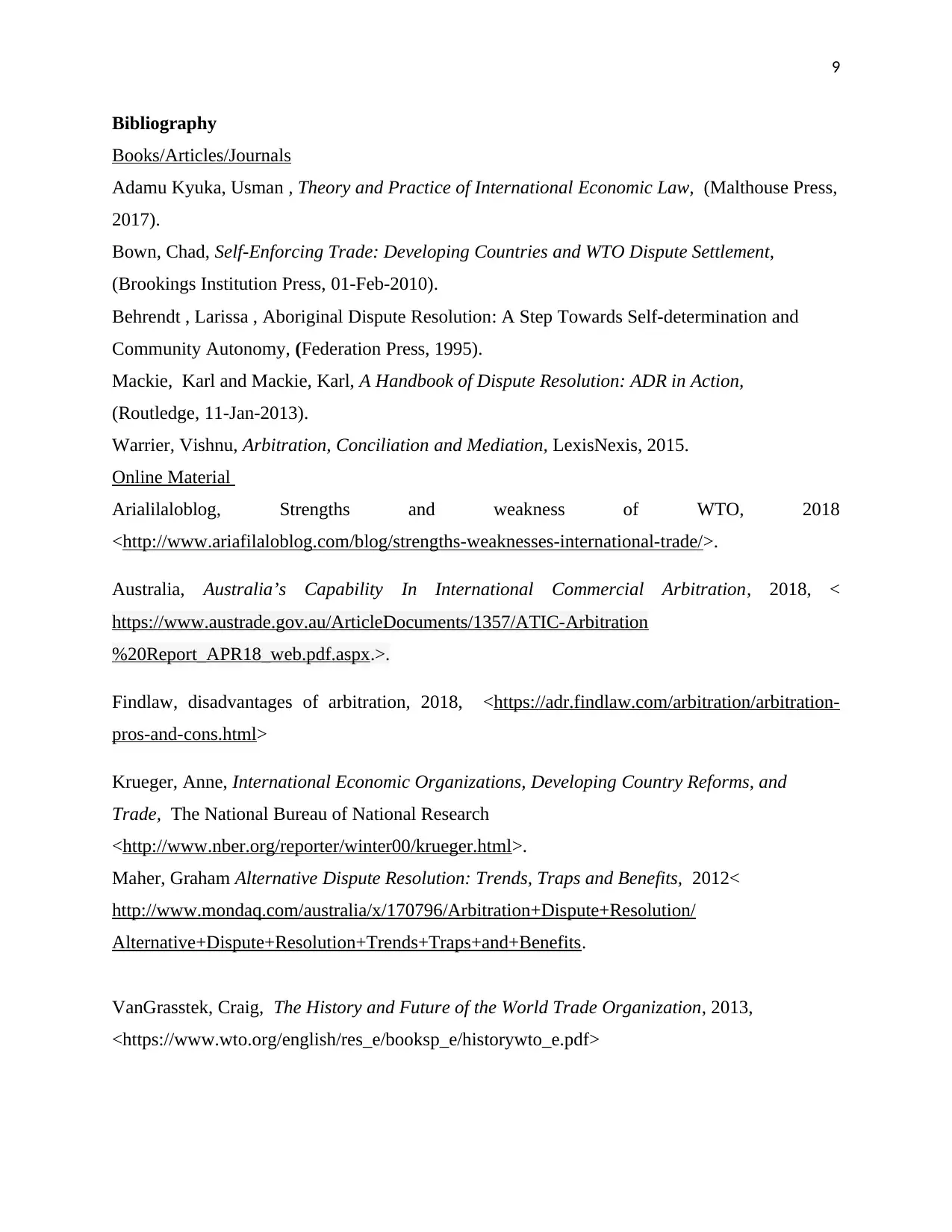
9
Bibliography
Books/Articles/Journals
Adamu Kyuka, Usman , Theory and Practice of International Economic Law, (Malthouse Press,
2017).
Bown, Chad, Self-Enforcing Trade: Developing Countries and WTO Dispute Settlement,
(Brookings Institution Press, 01-Feb-2010).
Behrendt , Larissa , Aboriginal Dispute Resolution: A Step Towards Self-determination and
Community Autonomy, (Federation Press, 1995).
Mackie, Karl and Mackie, Karl, A Handbook of Dispute Resolution: ADR in Action,
(Routledge, 11-Jan-2013).
Warrier, Vishnu, Arbitration, Conciliation and Mediation, LexisNexis, 2015.
Online Material
Arialilaloblog, Strengths and weakness of WTO, 2018
<http://www.ariafilaloblog.com/blog/strengths-weaknesses-international-trade/>.
Australia, Australia’s Capability In International Commercial Arbitration, 2018, <
https://www.austrade.gov.au/ArticleDocuments/1357/ATIC-Arbitration
%20Report_APR18_web.pdf.aspx.>.
Findlaw, disadvantages of arbitration, 2018, <https://adr.findlaw.com/arbitration/arbitration-
pros-and-cons.html>
Krueger, Anne, International Economic Organizations, Developing Country Reforms, and
Trade, The National Bureau of National Research
<http://www.nber.org/reporter/winter00/krueger.html>.
Maher, Graham Alternative Dispute Resolution: Trends, Traps and Benefits, 2012<
http://www.mondaq.com/australia/x/170796/Arbitration+Dispute+Resolution/
Alternative+Dispute+Resolution+Trends+Traps+and+Benefits.
VanGrasstek, Craig, The History and Future of the World Trade Organization, 2013,
<https://www.wto.org/english/res_e/booksp_e/historywto_e.pdf>
Bibliography
Books/Articles/Journals
Adamu Kyuka, Usman , Theory and Practice of International Economic Law, (Malthouse Press,
2017).
Bown, Chad, Self-Enforcing Trade: Developing Countries and WTO Dispute Settlement,
(Brookings Institution Press, 01-Feb-2010).
Behrendt , Larissa , Aboriginal Dispute Resolution: A Step Towards Self-determination and
Community Autonomy, (Federation Press, 1995).
Mackie, Karl and Mackie, Karl, A Handbook of Dispute Resolution: ADR in Action,
(Routledge, 11-Jan-2013).
Warrier, Vishnu, Arbitration, Conciliation and Mediation, LexisNexis, 2015.
Online Material
Arialilaloblog, Strengths and weakness of WTO, 2018
<http://www.ariafilaloblog.com/blog/strengths-weaknesses-international-trade/>.
Australia, Australia’s Capability In International Commercial Arbitration, 2018, <
https://www.austrade.gov.au/ArticleDocuments/1357/ATIC-Arbitration
%20Report_APR18_web.pdf.aspx.>.
Findlaw, disadvantages of arbitration, 2018, <https://adr.findlaw.com/arbitration/arbitration-
pros-and-cons.html>
Krueger, Anne, International Economic Organizations, Developing Country Reforms, and
Trade, The National Bureau of National Research
<http://www.nber.org/reporter/winter00/krueger.html>.
Maher, Graham Alternative Dispute Resolution: Trends, Traps and Benefits, 2012<
http://www.mondaq.com/australia/x/170796/Arbitration+Dispute+Resolution/
Alternative+Dispute+Resolution+Trends+Traps+and+Benefits.
VanGrasstek, Craig, The History and Future of the World Trade Organization, 2013,
<https://www.wto.org/english/res_e/booksp_e/historywto_e.pdf>
1 out of 9
Related Documents
Your All-in-One AI-Powered Toolkit for Academic Success.
+13062052269
info@desklib.com
Available 24*7 on WhatsApp / Email
![[object Object]](/_next/static/media/star-bottom.7253800d.svg)
Unlock your academic potential
© 2024 | Zucol Services PVT LTD | All rights reserved.




